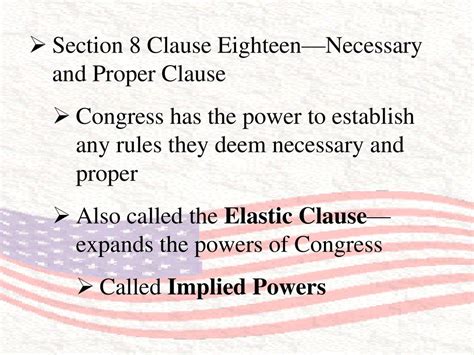Introduction
The Necessary and Proper Clause, also known as the Elastic Clause, is a crucial provision within Article I, Section 8 of the United States Constitution. It empowers the federal government to enact laws that are “necessary and proper” for carrying out its enumerated powers. This clause has played a pivotal role in shaping the federal government’s regulatory authority and the balance of power between the federal and state governments.

Definition of the Necessary and Proper Clause
The Necessary and Proper Clause states: “The Congress shall have the Power … to make all Laws which shall be necessary and proper for carrying into Execution the foregoing Powers, and all other Powers vested by this Constitution in the Government of the United States, or in any Department or Officer thereof.”
Significance of the Clause
The Necessary and Proper Clause serves several essential purposes:
- Expands Federal Authority: It provides the federal government with the flexibility to exercise powers beyond those explicitly enumerated in the Constitution.
- Promotes Effective Governance: It allows Congress to enact legislation necessary for the efficient and effective operation of the federal government.
- Preserves Federal Supremacy: It reinforces the principle of federal supremacy by empowering the federal government to enact laws that may override state laws in certain circumstances.
Historical Context
The Necessary and Proper Clause was included in the Constitution during the Convention of 1787 as a compromise between those who favored a strong national government and those who sought to limit its power. James Madison, a key architect of the clause, argued that it was essential to provide the federal government with the necessary authority to fulfill its constitutional responsibilities.
Landmark Cases
The interpretation of the Necessary and Proper Clause has been subject to debate and litigation throughout US history. Several landmark cases have shaped its application:
- McCulloch v. Maryland (1819): Established the principle of implied powers, allowing Congress to enact laws that are not explicitly stated in the Constitution but are necessary for carrying out its enumerated powers.
- Gibbons v. Ogden (1824): Gave Congress broad authority to regulate interstate commerce, further expanding the scope of federal power.
Modern Applications
The Necessary and Proper Clause continues to shape federal policy in a wide range of areas:
- Economic Regulation: Regulating interstate commerce, financial markets, and labor relations.
- Environmental Protection: Enacting laws to protect air, water, and natural resources.
- National Security: Establishing and maintaining armed forces, conducting intelligence operations, and protecting against foreign threats.
Controversies and Debates
The application of the Necessary and Proper Clause has sparked ongoing debates and controversies:
- Scope of Federal Power: Critics argue that the clause has been used to expand federal authority beyond its intended limits.
- Implications for State Sovereignty: Some contend that the clause has eroded state power and autonomy.
- Constitutional Interpretation: The extent to which the clause allows for judicial discretion in interpreting the Constitution remains a contentious issue.
Tables
Table 1: Enumerated Powers of the Federal Government
| Power | Relevant Constitutional Provision |
|---|---|
| Taxing and spending | Article I, Section 8, Clause 1 |
| Regulating interstate commerce | Article I, Section 8, Clause 3 |
| Creating armed forces | Article I, Section 8, Clause 12 |
| Establishing a postal service | Article I, Section 8, Clause 7 |
| Declaring war | Article I, Section 8, Clause 11 |
Table 2: Landmark Cases Interpreting the Necessary and Proper Clause
| Case | Year | Holding |
|---|---|---|
| McCulloch v. Maryland | 1819 | Established implied powers doctrine |
| Gibbons v. Ogden | 1824 | Gave Congress broad authority to regulate interstate commerce |
| United States v. Darby | 1941 | Upheld federal regulation of labor relations under commerce power |
| Wickard v. Filburn | 1942 | Expanded federal regulation of agriculture |
Table 3: Economic Regulations Enacted under the Necessary and Proper Clause
| Regulation | Purpose |
|---|---|
| Dodd-Frank Wall Street Reform and Consumer Protection Act | Financial market oversight |
| Sarbanes-Oxley Act | Corporate governance and accounting standards |
| National Labor Relations Act | Labor relations and collective bargaining |
Table 4: Environmental Protection Measures Implemented under the Necessary and Proper Clause
| Measure | Purpose |
|---|---|
| Clean Air Act | Regulates air pollution emissions |
| Clean Water Act | Protects surface water quality |
| Endangered Species Act | Protects endangered and threatened species |
Strategies for Understanding the Necessary and Proper Clause
- Study the Constitutional Text: Analyze the text and context of Article I, Section 8 to gain a thorough understanding of the clause’s original meaning.
- Examine Court Precedents: Review landmark cases that have interpreted the clause and established legal principles.
- Consider Historical Context: Explore the debates and compromises that shaped the development of the Necessary and Proper Clause.
- Apply to Contemporary Issues: Analyze current debates and controversies regarding the scope and application of the clause.
Effective Strategies for Interpreting the Necessary and Proper Clause
- Consider the Purpose of the Law: Determine whether the law is intended to carry out an enumerated power of the federal government.
- Examine the Nexus between the Law and the Enumerated Power: Analyze the extent to which the law is connected to and necessary for the effective exercise of the power.
- Weigh the Impact on State Sovereignty: Consider potential conflicts between the law and state powers, balancing the need for federal regulation with the principles of federalism.
- Apply a Reasonable Interpretation: Avoid extreme interpretations that could undermine the intent of the Constitution or unduly expand federal authority.
